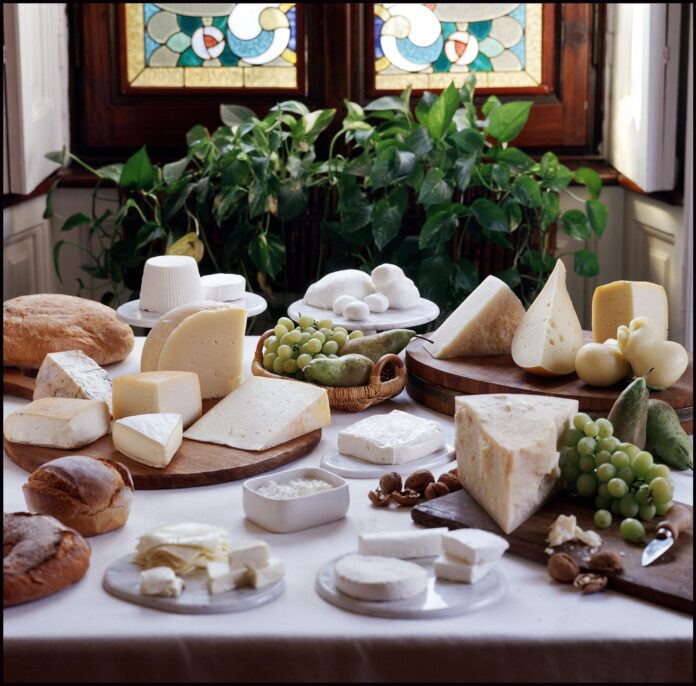These days, Italian-style cheese is part of everyday life. From gooey mozz melted atop classic pizza, to strip steaks drizzled with gorgonzola cream sauce, to the flourish of umami-rich parm crowning bowls of pasta from New York City to Tokyo, these cheesy ingredients are the culinary backbone of recipes enjoyed far beyond Europe’s boot-shaped country. And while Italy’s cheesemaking traditions have also traveled beyond its borders—inspiring farmers, makers, and affineurs around the world—there’s still nothing quite like the real thing.
Many Italian cheeses are infinitely versatile in the kitchen, but that doesn’t mean they’re any less revered than their cheese board brethren. Savory shards of Parmigiano-Reggiano (Italy’s “King of Cheeses”), for example, might be enjoyed with a glass of sparkling wine, while that same wheel’s rind, simmered in a brothy pot of white beans and escarole, is just as much a revelation. This is partly due to the fact that many well-known types of Italian-made cheeses are held to the strictest standards. The European Union has granted more than 500 Italian cheeses PDO (Protected Designation of Origin) status, a legal designation that ensures recipients are produced in their established region, using the traditional methods and specific ingredients that make each unique. Here are some considerations that come into play:
Nearly every Italian region produces some sort of dairy—and along with it, some sort of cheese, from piquante Gorgonzola ripened in the northern Piedmont and Lombardy regions, to mild and milky Mozzarella di Bufala hand-stretched in southern Campania. Italian cheese is always crafted from top-quality milk, whether it’s made from the milk of sheep, cows, goats, buffalo, or a mix. Animal welfare and a grass-fed diet are often built into the exacting PDO standards as well: for example, Sardinia’s Pecorino Sardo is made primarily from the milk of sheep that graze freely on that island’s lush and shrubby hillside pastures. Many PDO designations also specify that cheeses may only be made from the milk of certain breeds—such as the firm, Alpine wheels of Piave, which must be made using an 80 percent minimum of milk from the local Bruna Italiana, Valdostana Pezzata Rossa, Frisona Italiana, or Grigio Alpina cows.

Much like wine, Italian cheese is an agricultural product reflective of its origin’s soil, terrain, flora, and climate. From the vegetation consumed by the dairy herd to the conditions under which a cheese is aged, each one takes on very particular regional characteristics. For instance, Fontina Val d’Aosta is made only from the unpasteurized milk of Valdostana cows pastured in northern Italy’s Aosta Valley. The resulting Alpine cheese is creamy and firm, and its ripening process—up to three months of rest in natural stone caverns—enhances the milk’s underlying nutty, buttery, grassy notes.
After milk has been sourced, it’s up to talented Italian artisans to craft it into a cheese that is consistent from wheel to wheel, and is a unique expression of its particular place, producer, and tradition. Cheesemaking is not an easy task, and in Italy, it’s an artform that carefully balances science, culture, and craft. Each cheesemaker and affineur relies on methods honed over generations. And in some cases, the artisans themselves are a component of the authenticity of the cheese; Gorgonzola, for example, may only be made by 40 small family dairies and commercial producers. Grana Padano, one of Italy’s most popular exports, was created by the Cistercian monks of Chiaravalle Abbey in Lombardy—though it has long outgrown the monastery and is now more widely produced.

The history of cheese in Italy dates back thousands of years and is an important part of Europe’s food culture. Pecorino Romano was used to feed legions of Roman soldiers; the salty, low-moisture cheese was deemed a vital source of fat, salt, and protein, and is still prized for its long shelf life today. Production of Parmigiano-Reggiano has barely changed since the 12th century; it’s still made from a mixture of whole and skimmed milk in large copper cauldrons, and only in the regions of Emilia-Romagna and Lombardy. Lombardy’s soft, washed-rind Taleggio has been made much the same way since the Middle Ages, too, drawing its distinct pungency from ripening in the naturally cool caves of Val Taleggio.
Italy’s rich and storied history—along with its diverse climate, geography, and regional traditions—make it particularly fertile ground for cheese production. Ancient recipes and techniques have persisted for millenia, occasionally adapting and evolving with technology, but always with the utmost care and oversight. When no substitute will do, ask your local cheesemonger for Italian-made cheese, or look for “made in Italy,” on the label at the supermarket.




